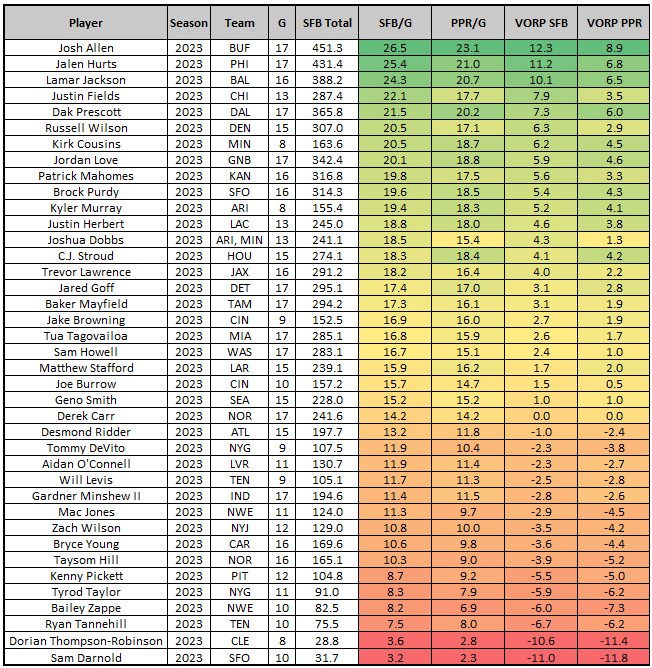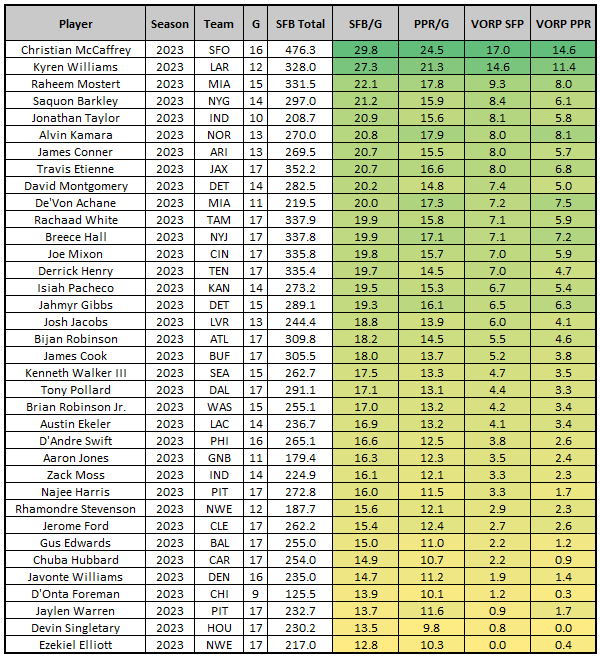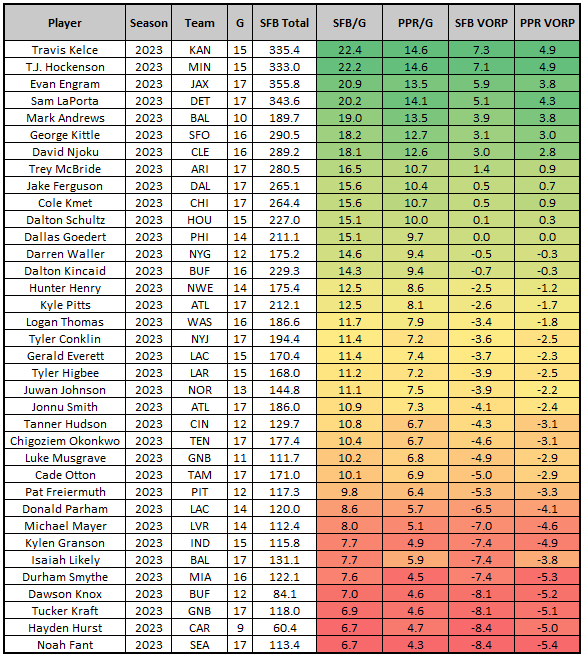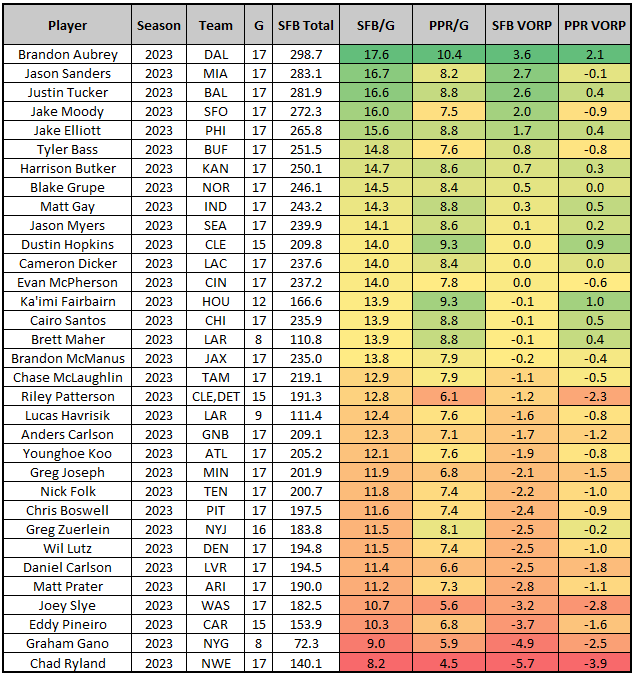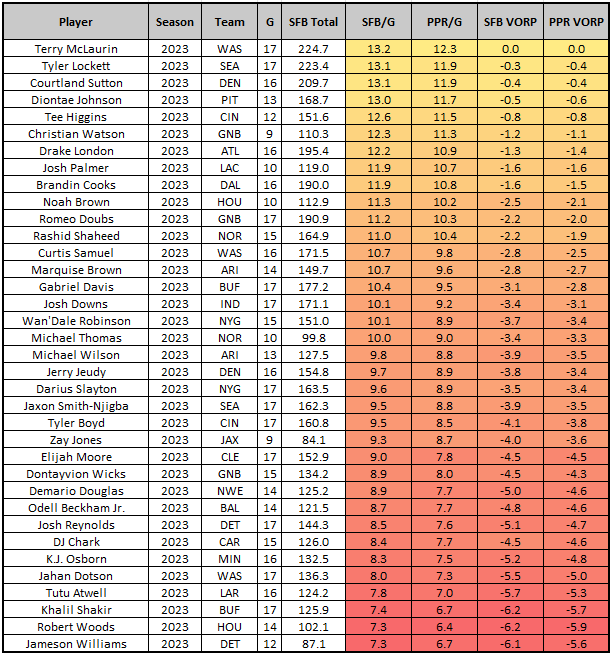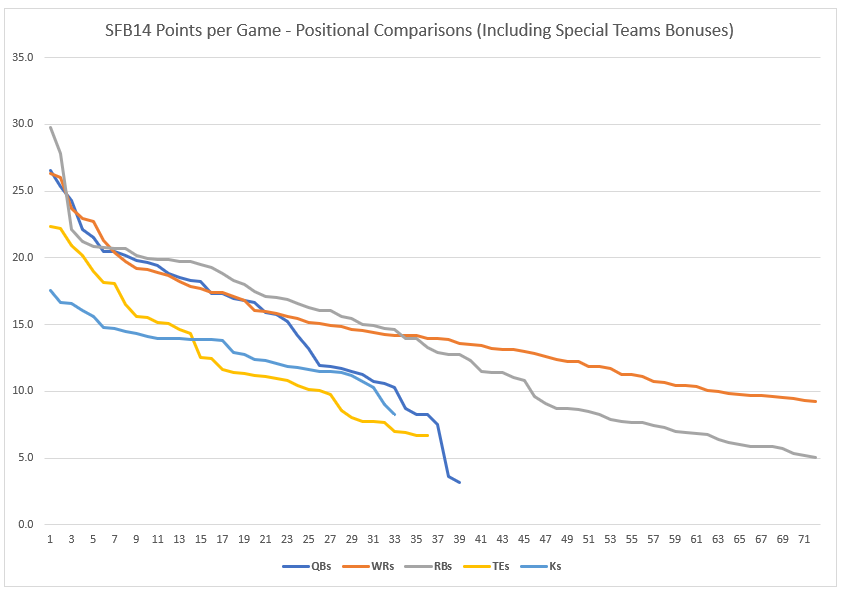Scott Fish Bowl 14 is upon us! I have the scoring, the most valuable players, and positions based on how the format would have played out in 2023, and what I believe is the best strategy to handle the biggest curveball this tournament has ever thrown at its participants.
The full rules can be found here. As I alluded, the biggest change is the addition of MASSIVE, game-warping bonuses for return yardage (1 point for every 5 yards) and special teams TDs (10 points apiece), which I’ll cover in detail at the end of this article. However, some other highlights include:
6-point passing TDs, but halved scoring for passing yards
0.5-point bonuses for rushing first downs, and 0.25-point bonuses for rush attempts
Variable bonuses for receptions and receiving first downs based on position, with TEs getting the most help
Yardage-based kicker scoring that awards 3.3 points for a made extra point, with kickers allowed in the FLEX on MFL, and Sleeper instead having a required K lineup spot.
Drafts have third-round reversal
A six-week playoff tournament where your season average score is added to your total during each of the first three weeks, and half your season average is added to your total for each of the final three weeks
That sounds like a lot (and it is), but don’t sweat it too much. This article covers everything you need to crush your competition in the industry’s most beloved charity event.
I’ve applied SFB14’s unique scoring to the 2023 season. However, I’ve done so with one omission: I’ve excluded that all-important special teams scoring, as I believe it is easier to fully digest this rule’s ramifications after gaining a full understanding of how the scoring otherwise functions within each position. If you only want to read my strategy for dealing with return yardage, scroll down to the bottom.
A final note before diving in: remember that macro trends in 2024 may be different than in 2023. Don’t over-focus on last year’s results, as there could be new trends and pockets of positional value in 2024. (For a full, non-SFB14-related take on this topic, I recommend my 2023 postmortem.)
Quarterbacks in SFB14
QBs earn only half the points for passing yards they would in traditional leagues. And the bonuses for carries and rushing first downs mean hyper-mobile QBs have an even larger advantage than usual. Russell Wilson’s combination of the 5th-most rushing first downs and 3rd-highest TD rate carried him to a QB6 finish last year despite ranking just 19th in passing yards.
The trio of Josh Allen, Jalen Hurts, and Lamar Jackson were significantly more valuable than in traditional superflex leagues last year, as can be observed by comparing the VORP (Value Over Replacement) columns on the right. This simple calculation of a player’s FPG against the baseline player at their position (QB24, RB36, WR36, TE12, or K12) gives us a handy idea of how value ebbs and flows throughout the rankings.
The TD-dependent scoring also means the QB position falls off a cliff once we run out of competent offenses. If you want to fill your Superflex spot with a QB, ensure you take one before only the anemic offenses remain.
Running Backs in SFB14
The carry and rushing first-down bonuses gave boosts to early-down grinders like James Conner and David Montgomery, but overall, the RB position was still ruled by the unbelievable three-down volume of Christian McCaffrey and Kyren Williams last year.
It’s also worth noting that broadly, back-end RB1s and RB2s are much more valuable in SFB14 scoring than in PPR formats. RB21 Tony Pollard averaged the same FPG (17.1) as WR18 Davante Adams. Pollard also offered significantly more VORP (4.4 to 3.1) — a dynamic that would have been reversed in PPR scoring.
Tight Ends in SFB14
By VORP, TE1 Travis Kelce was slightly less valuable than RB9 David Montgomery last year. The top-4 TEs had a noticeable VORP advantage in SFB14 scoring compared to PPR scoring, but all boats at the position get lifted by the TE-exclusive first down bonuses.
That doesn’t mean you shouldn’t draft an early TE if you believe he can turn in a season like the Travis Kelce of old. Just be aware that much like traditional leagues, the top of the position was much flatter last year than we’ve previously been used to. The RB17 (Josh Jacobs) outscored all but the top-5 TEs while offering more VORP than all aside from the top-2.
Kickers in SFB14
Even though you can expect 20 kickers to post approximately WR4 numbers, I would still not be the first to draft one. Kickers offer the worst VORP of any position, with only a 3.6 FPG difference last year between the K1 and K12.
The emphasis on extra points further boosts kickers on good offenses and penalizes ones on mediocre offenses compared to traditional scoring. Jake Moody was a top-4 kicker by SFB14 scoring last season, while Dustin Hopkins (the K3 in traditional formats) was just the K11.
Wide Receivers in SFB14 (without Special Teams Bonuses)
Before considering special teams scoring, the WR position functioned very similarly to how it did in PPR leagues last year, with the top-5 WRs separating and providing more VORP than all RBs aside from McCaffrey and Williams.
However, unlike in PPR scoring, WR6 Puka Nacua was outscored by a whopping 13 RBs last year (and out-VORPed by 16, due to the lesser depth at RB). If not for the twist of return yardage, it would be clear that drafters should heavily prioritize starting-level players at the RB position over WRs. So let’s start digging into that twist.
Special Teams Bonuses
Until now, I’ve excluded return yards and return TD scoring from my analysis. That’s because it’s exceedingly difficult (if not impossible) to project which players will be handling return duties in 2024, and I didn’t want anyone’s takeaway to be that Rashid Shaheed (WR6), Marvin Mims (WR32), Xavier Gipson (WR33), or Jamal Agnew (WR36) specifically are going to repeat their special teams-fueled production from 2023.
That’s right; these bonuses are massive and will make a major difference to the format, as Fantasy Points’ own Daniel Keys explains in detail here. In summary, any player who has both a full-time role on offense and is his team’s dedicated returner could easily crack the top-10 overall scorers, especially considering the NFL’s new kickoff rule should lead to many more kickoff returns than in recent seasons.
But again, selecting a specific player in early July with the expectation that he will return kickoffs and punts will likely end in disappointment. The competitions for these jobs are ongoing throughout the preseason, and we likely won’t know most teams’ returners until Week 1. For example, I (very badly) wanted to cape up for Greg Dortch in this article, but DeeJay Dallas also has return experience and could win the job. Or the Cardinals could employ a returner-by-committee. We have no idea!
https://t.co/iJRqE05kBS pic.twitter.com/uDsQUPtact
— 32BeatWriters (@32BeatWriters) June 21, 2024
Instead of over-drafting a speculative returner who could be cut before the season, simply accept what you don’t know. I expect many of the best returners to be added on waivers early in the year, and whichever teams add the most will likely have a big advantage.
However, we can draft to maximize our chances of capturing those valuable return bonuses without betting the house on any specific player. In 2023, 76.3% of SFB special teams fantasy points (among flex-eligible positions) were accrued by WRs. Even with the new kickoff rule, I am skeptical that any RB with a real offensive role will see significant return work, given the position’s punishing nature and added injury risk. That means we should lean toward the WR position for filling out our 6 FLEX spots to give ourselves as many shots as possible at this asymmetrical upside.
Here, I’ve charted each player’s FPG finish from 2023 by position, to directly compare the scoring of (for example) the RB10 to the WR10, the QB10, the TE10, etc. You can observe where the dropoffs occurred at each position with the special teams scoring bonuses included.
Last year, under the previous rules regime in which teams averaged just 1.1 kickoff returns per game, the WR50 outscored the QB26. WRs significantly outscored RBs after the top-36, and were only marginally less productive from the WR7/RB7 to the WR33/RB33 range. With this year’s kickoff rule, we should expect the orange line to shift even higher.
And now, imagine if Tyreek Hill (or Tank Dell, or Deebo Samuel, or any starting WR) began getting significant return work, as Hill’s own coach has indirectly suggested.
“Overall, it wouldn’t shock me if every number one receiver and every number one running back in the league is raising their hand to return kicks Week 4.”
— The Coachspeak Index (@CoachspeakIndex) June 6, 2024
- #Dolphins HC Mike McDaniel on the new kickoff rules pic.twitter.com/lixfTk5p3C
If you don’t buy that out of McDaniel, you might be left with the conclusion that WR will be incredibly deep with return specialists, making the offense-only WRs less valuable.
But if his prediction comes true, a killer contrarian strategy would be to take shots on WRs wherever doing so does not significantly hurt you at another position, to capture the upside of as many offense + special teams dual threats as possible. Remember, SFB14 lineups only require 1 QB, 1 RB, 1 WR, and 1 TE (with a Superflex spot and 6 normal FLEX spots tacked on).
Overall Scott Fish Bowl 14 Strategy
An ideal draft might involve securing an elite QB, an RB with a chance for a Christian McCaffrey-level season, and the cheapest TE with top-3 upside you can get your hands on before mostly shifting focus to drafting WRs (especially young and fast ones), who each individually have upside to earn return work and become a massive steal at ADP.
While starting a QB in your Superflex spot will be ideal, the TD-heavy and yardage-light scoring will create a big dropoff once we run out of competent offenses. Back-end QB2s, and especially QB3s, will likely be overvalued in drafts, as it seems entirely viable to play a WR in the Superflex position if you miss out.
Most teams will likely start at least 2 RBs every week, and as mentioned, the floor is generally higher for RB2s compared to WR2s. This is the only place I’d consider detouring from the elites-then-WRs strategy I outlined, but arguably, the return-related upside for an individual WR is higher than for most RBs — and in a tournament with thousands of people, you may as well draft for upside.
Even independent of the position flattening at the top last year, TEs suffer because they rarely return kicks. You’ll want to fill the spot in your lineup, as the TE7 was about on par with the WR14 last year, but I would certainly prioritize an elite QB and RB first.
The kicker position looks to be relatively flat. You’ll likely start at least one in your FLEX on MFL, but especially if you’re drafting on Sleeper (where kickers are not FLEX-eligible), I would not prioritize them before the final few rounds. Unlike every other position, kickers have no season-long upside or breakout potential.


